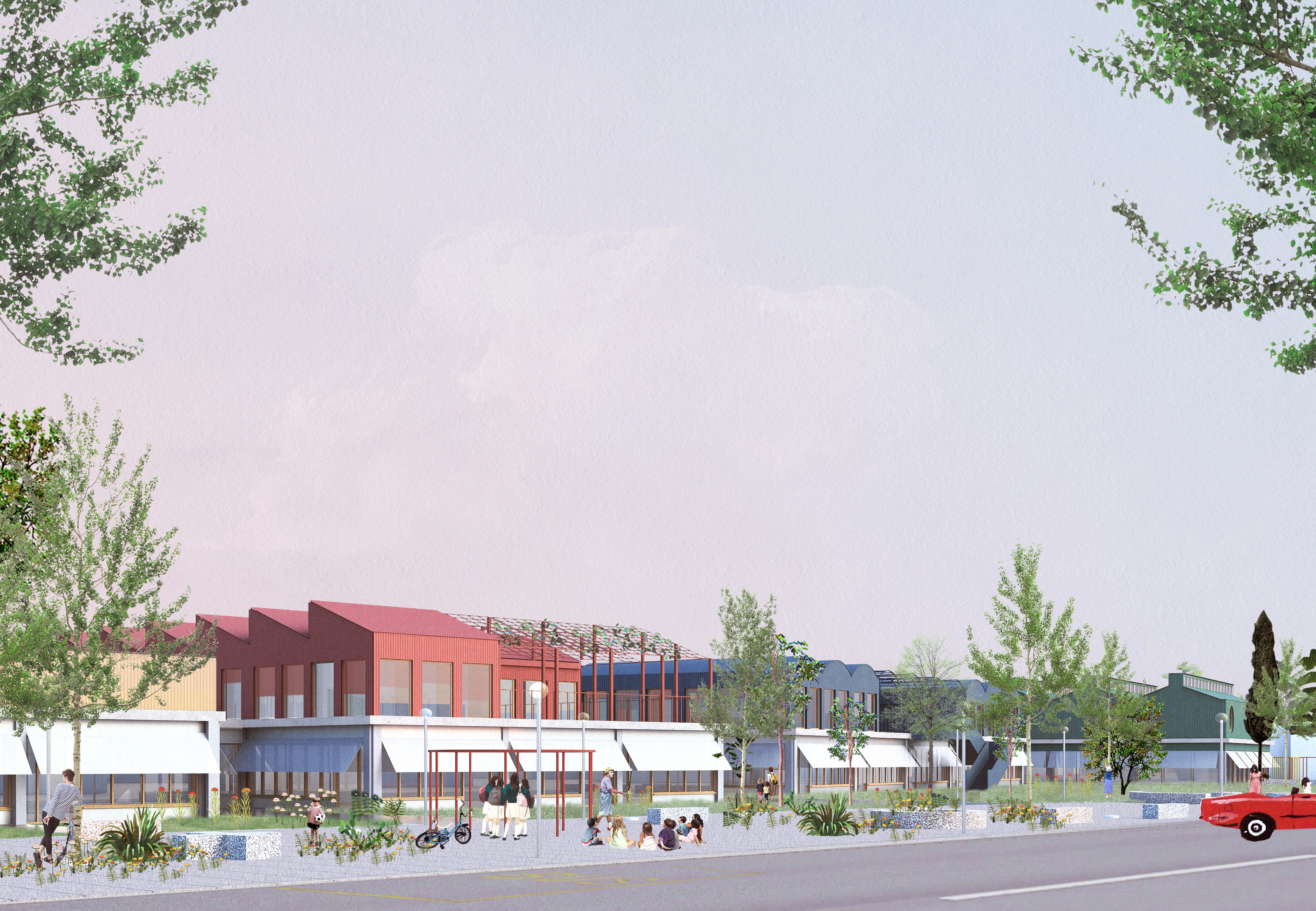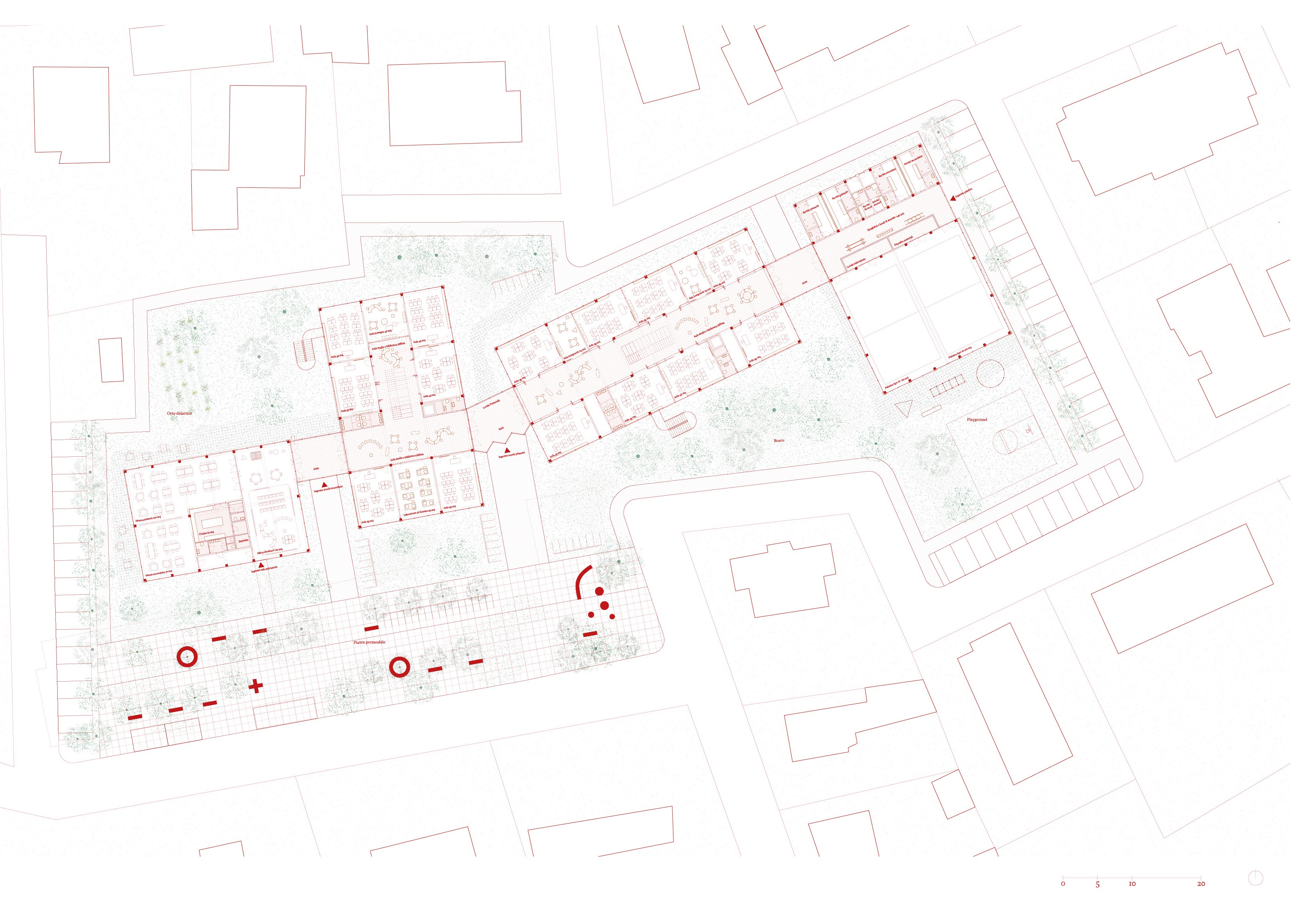DEAD POETS SOCIETY
Title _ Dead poet society
Period _ 2023
Location _ Marene, Italy
Status _ Entry, Two phased design competition
With _ Samuele Bertoni


The intervention is located in the city of Marene, in the Province of Cuneo, in an area close to the city center, which includes the old school deposit and the adjacent Piazza Sinaglia.
The project fits in continuity with the urban fabric, with a vision geared toward nurturing a process of urban permeability.
The urban artifact will fit among multiple urban voids.
The building's shape will redesign the existing public space and make it a central town's hub.
Between the school pavilions, new areas for citizenship will be grafted, such as a community garden, new parking lots, a square with adaptable street furniture, and a small public part dedicated to sports.
Special attention has been paid to the presence of nature and new urban mobility, in fact within it several parking spaces for bicycles and new means of locomotion have been placed, as well as electric columns for cars, stimulating a more sustainable mobility.
The project fits in continuity with the urban fabric, with a vision geared toward nurturing a process of urban permeability.
The urban artifact will fit among multiple urban voids.
The building's shape will redesign the existing public space and make it a central town's hub.
Between the school pavilions, new areas for citizenship will be grafted, such as a community garden, new parking lots, a square with adaptable street furniture, and a small public part dedicated to sports.
Special attention has been paid to the presence of nature and new urban mobility, in fact within it several parking spaces for bicycles and new means of locomotion have been placed, as well as electric columns for cars, stimulating a more sustainable mobility.

From a landscape point of view, the school is immersed in a completely new place full of nature, which acts as a filter between the school and the urban space.
The selection of tree essences was crucial and made with a keen eye since the presence of community gardens is a well-known educational incentive for the participation of all citizens.
In addition, the species selection focuses on native species by including rows of local shrubs. The other species selected offer a potential educational stimulus and characterize the open spaces.
In the area dedicated to the community garden, we find crops with a short cycle (corn, beans, tomatoes) and aromatic gardens, which can also be found via the plaza adjacent to the canteen and from the sidewalk behind.
In the more impermeable areas, where the organized playgrounds are, we find fruit trees, and deciduous trees that border a soft path through the surrounding greenery.
The institute and the park will thus form one large pedestrian island that will catalyze the school community and urban life.
Interventions in this area aim for spatial continuity between the school and the park, following principles of safe routes and adequate lighting for evening use as well. Access is placed on the new square located at Via Trieste, a connecting point for mobility on which we already find bicycle paths and consolidated public transport lines. Pupils will be welcomed by a large outdoor plaza overlooked by the main front of the school and in which an interconnecting space is planned for public transport parking, a drop-off area, and a parking area for bicycles.
The institute and the park will thus form one large pedestrian island that will catalyze the school community and urban life.
Interventions in this area aim for spatial continuity between the school and the park, following principles of safe routes and adequate lighting for evening use as well. Access is placed on the new square located at Via Trieste, a connecting point for mobility on which we already find bicycle paths and consolidated public transport lines. Pupils will be welcomed by a large outdoor plaza overlooked by the main front of the school and in which an interconnecting space is planned for public transport parking, a drop-off area, and a parking area for bicycles.



The architectural identity is an aggregative one: the classrooms min buildings grouped create the metaphor of a small town.
The spaces of the school gather around the hall that is located in both central teaching halls, a kind of large double-height square, the civic center of a school city in which future students will have space to experience a collective life and sociability.
The auditorium and the hall/agora are strategically placed near the entrance so that they are directly visible; their relative placement, together with the gatehouse, allows easy access even to outside users in case of extracurricular events.
In contrast, the study room and library are open and permeable environments that become an integral part of the fabric of informal integrative spaces. These different environments fit between classrooms and laboratories. The relationships between the areas promote fluidity of use, as well as, the flexibility of remodeling.
informal practice
︎ informal_practice / informalpractice.xyz@gmail.com
© INFORMALPRACTICE / Privacy Policy
Unless otherwise stated, all content on this website is the intellectual property of INFORMALPRACTICE and may not be used or reproduced without express consent.
Unless otherwise stated, all content on this website is the intellectual property of INFORMALPRACTICE and may not be used or reproduced without express consent.